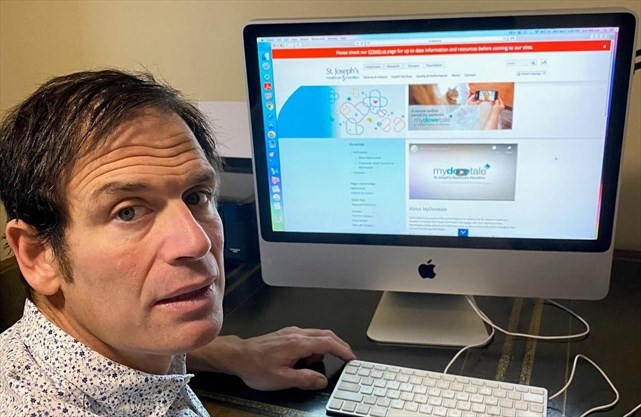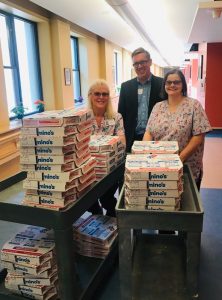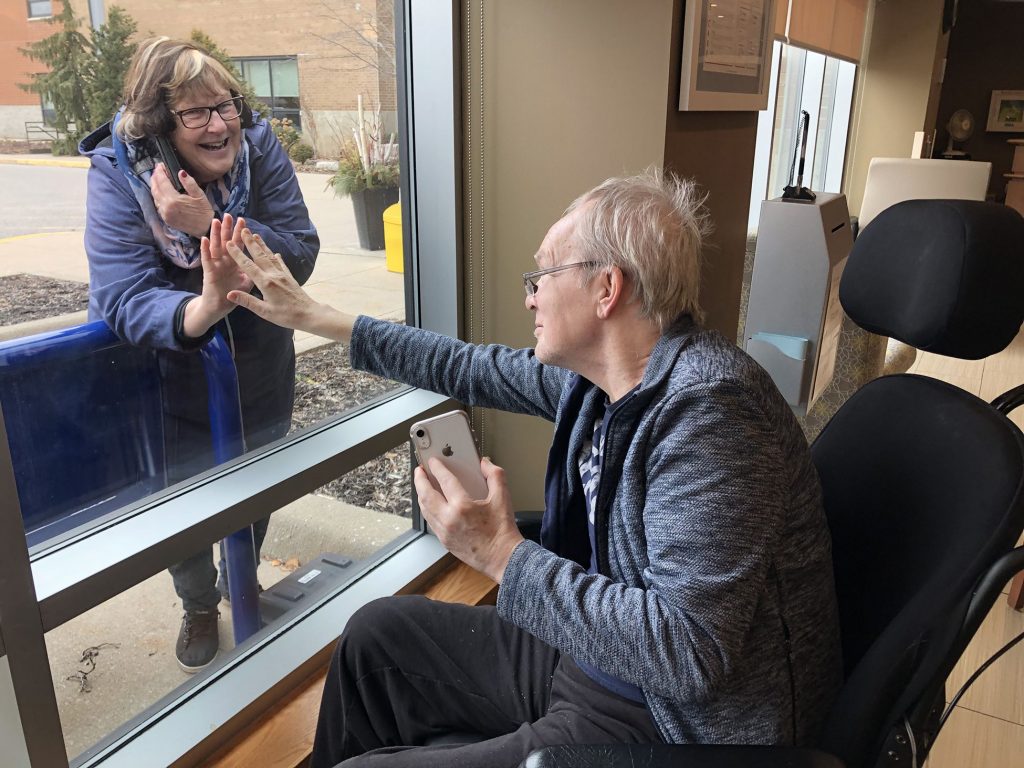St. Joseph’s Health System & Niagara Health launch new pilot surveillance project to protect the most vulnerable in our health system
April 20, 2020 – COVID-19 has had a devasting effect within many congregate care facilities caring for vulnerable elderly residents, prompting the Ontario government to call for greater testing in long-term care and retirement homes.
With that in mind, St. Joseph’s Health System (SJHS) and Niagara Health are taking the vital step in testing all asymptomatic patients, residents and select staff within its long-term care, retirement home and congregate settings as part of a pilot surveillance project.
Under the directive of Dr. Tom Stewart, CEO of St. Joseph’s Health System and Niagara Health, and the SJHS Executive team, supported by Research Institute and Lab, the project will test our most vulnerable patients and residents, including those living in long-term care, to save lives.
Researchers at the Research Institute of St. Joe’s Hamilton, McMaster University, Guelph Assessment Centre, Public Health Ontario Lab and select public health units across the GTA are working together to test thousands of samples collected from long-term care facilities and retirement homes.
“We are testing the prevalence of asymptomatic COVID positive cases that could inform future testing strategies and prevention measures to curb the spread of this devastating virus and save lives,” Says Dr. Jack Gauldie, Vice-President of Research at St. Joseph’s Healthcare Hamilton. “It’s vital we learn how we can protect our most vulnerable population and our staff today and, in the future. We need to share our findings widely to make changes to how we protect the elderly living in congregate settings.”
“St. Joseph’s Health System and Niagara Health are committed to delivering integrated care across the continuum,” says Dr. Tom Stewart. “With our capacity and network of hospitals, research laboratories, long-term care home, Home Care, and retirement homes, it would be irresponsible not to put our collective efforts together in the fight against COVID-19. If our surveillance project demonstrates that asymptomatic cases can be COVID positive, it will dramatically change the COVID-19 response and prevention strategy going forward and most importantly will save lives.”
Testing of staff, residents and patients across St. Joseph’s Health System and Niagara Health has already begun.
“We have tested all 111 long-term care residents for COVID-19 whether they had symptoms or not. All results have come back negative,” Says Lynn Guerriero, President of Niagara Health. “We need to do everything we can to minimize the risk to our residents, and testing will continue on a regular basis to support a safe environment and understand more about this virus.”
The Office of the Chief Medical Officer of Health, working with the Ministry of Long-Term Care and Ontario Health, will review results from these tests and work to refine testing guidance as appropriate to support continued testing of asymptomatic residents and staff.
Partnering Organizations
- Research at St. Joes
- St. Joseph’s Villa Dundas
- St. Joseph’s Health Centre Guelph
- St. Joseph’s Lifecare Centre Brantford & Stedman Community Hospice
- St. Joseph’s Home Care
- Niagara Health
- Hamilton Regional Laboratory Medicine Program
- McMaster University
- Wellington-Dufferin-Guelph Public Health
- Guelph Assessment Centre
- Hamilton Public Health
- Brant County Health Unit
- Niagara Regional Public Health
- PHO Lab
- Ontario Public Health
- Ministry of Health & Ministry of Long-Term Care
St. Joseph’s says use of virtual visit tech has increased 450 per cent

Rob DeLuca, a bodybuilder with stage-four lung cancer and pulmonary hypertension, uses St. Joseph’s Healthcare Hamilton’s digital patient portal, MyDovetale, from his Ancaster home.
Apr 01, 2020 by Sebastian Bron Hamilton Spectator
For Rob DeLuca, an ordinary trip to the doctor’s office often feels like tiptoeing through a room filled with trip wires.
The bodybuilder with stage-four lung cancer and pulmonary hypertension is acutely vulnerable to commonly transmitted germs. Touchscreen parking posts, arm rests on chairs, door handles, washrooms: they’re all akin to booby traps that could trigger an infection and kick his immune system into overdrive.
But that’s changed as the outbreak of COVID-19 has forced health-care providers to embrace physical distancing and modify their outpatient care services.
DeLuca was one of more than 1,000 at-risk St. Joseph’s Healthcare Hamilton (SJHH) patients to have received virtual care in March, chatting with doctors and getting condition updates from the comfort of their own homes.
“It’s made a big difference, especially since we’ve always had to be ultra-mindful when going to the doctor and now that’s been (amplified) with the virus,” said DeLuca, who meets with a respirologist every three months.
“There’s no travel, getting through several doors, touching many surfaces. There’s more time to discuss with (the doctor) and my wife can sit comfortably on the couch taking detailed notes.”
SJHH has seen an approximately 450 per cent increase in virtual-care volume since its personalized, digital patient portal, MyDovetale, was streamlined last month to cope with the number of people who wouldn’t be able to access on-site services.
Tara Coxon, chief information officer, said SJHH has seen an increase from 100 patients before the crisis — most of them mental health — to about 5,000 now across 19 clinics.
“Emergency visits to clinics are still operating, but for the part we’ve had every service go digital,” she said.
The user-friendly system has given doctors a reliable means of adapting their care to the current limits of the health crisis. For patients whose technical capacity is underdeveloped, like seniors, the health centre has a team of nurses and researches help get them on board.
“Physical distancing is critically important during COVID-19, and this has helped us go on with business as usual,” said Dr. Nathan Hambly, a respirologist at SJHH’s Firestone Clinic and DeLuca’s doctor.
The Firestone Clinic has about 700 patients with complex respiratory diseases, a majority of which boast survival rates of around three to five years.
With appointments typically scheduled months ahead of time, Hamby said the virtual portal — and in particular seeing his patients over a screen — has proven imperative in offering patients consistent, accurate care during the health crisis.
“One might say that a telephone would be just as good in these situations, but it isn’t. By looking at a patient, you’re able to ask questions and see their breathing and how hard it is for them to breath in real time,” he said.
Sebastian Bron is a Hamilton-based reporter at the Spectator. Reach him via email: sbron@thespec.com
NEWS Mar 29, 2020 by Craig Campbell
 Whether implementing life-saving protocols or keeping families connected, front-line staff at the St. Joseph’s Villa long-term care home are stepping up for at-risk residents during an unprecedented time.
Whether implementing life-saving protocols or keeping families connected, front-line staff at the St. Joseph’s Villa long-term care home are stepping up for at-risk residents during an unprecedented time.
Villa president John Woods said the Villa is an essential service – and the entire team are proud essential service workers.
“In every department, there are small acts of kindness and courage every day,” Woods said.
No personal visits inside or outside the building are allowed, other than limited exceptions for very ill residents or those requiring end-of-life care.
Villa registered practical nurse Elaine Ford said those necessary restrictions mean difficult times for residents and their families.
“At a time of concern, our residents are separated from their families. We’re seeing a lot of tears. We’re all doing our best to comfort them,” Ford said.
Ten therapeutic recreationists (TR) working in the Villa’s various residential areas keep elderly residents in contact with family and friends through phone and Skype video calls.
Staff arranged for a resident’s family members to wave to her, holding signs with personal messages, from the parking lot below.
“We had them call my work cell and they talked through the window,” said TR Pamela Tasane. “Everyone was crying – in a good way.”
On Friday, March 27 at 11 a.m., Villa staff held the first of what is planned to be a regular Let’s Make Noise event, where family members pull into the parking lot and honk their horns and make noise, letting residents know they’re there.
“The Villa team is getting creative in keeping connections strong while visiting is restricted,” said St. Joseph’s Villa Foundation chief development officer Sarena Paton. “This will be a weekly event, while the community and the country work together to keep people safe and healthy.”
Amanda Rip, a therapeutic recreationist, said her goal is to connect residents with their loved ones, and she feels fortunate to have that role.
In the past week, she has facilitated Skype and phone calls and birthday celebrations from the parking lot. She described it as social distancing at its finest.
“Seeing the happiness on a resident’s face when they see their loved ones, whether on the computer screen or across the parking lot singing ‘Happy Birthday,’ is truly a special moment,” Rip said.
The community, in return, is stepping up to show support for Villa front-line workers.
Paton said Dave Weber, senior partner of Sims Advertising and a Villa volunteer, ordered 300 slices of pizza for the Villa’s night shift and issued a challenge on social media.
“Frontline staff is demonstrating real care and compassion … it would be a good idea to send them some comfort food to say thanks,” Weber said.
Schuurman Greenhouse and Holland Park Garden Gallery dropped off hundreds of plants and flowers to thank staff and brighten residents’ spirits.
Villa administrator Mieke Ewen said it’s touching to see the community rally behind long-term care staff and residents.
“We feel it and we’re so grateful,” Ewen said. “This kindness gives us comfort and helps us get through all the changes and challenges.”
St. Joseph’s Villa Foundation president and CEO Don Davidson thanked the community for standing with the long-term care home.
“We’re so proud of the Villa’s front-line workers as they continue to care for, and protect, Villa residents,” he said. “Our sole focus right now is supporting the Villa through this crisis and emerging from this moment stronger and more united.”
Davidson said Margaret’s Place Hospice construction continues uninterrupted.
“We live in an incredible community that supports community,” he said. “Now more than ever, your support matters.”
Davidson and St. Joseph’s Villa Foundation board chair David Curto noted the significant role the institution’s front-line staff are playing in a letter to the community, that could not be published in the Dundas Star News due to COVID-19-related space reductions.
“As our country is grappling with protecting and maintaining the health and well-being of Canadians and lessening the impact on our health-care system, the Villa team continues to go above and beyond, without hesitation – just as they always do,” Davidson and Curto said.
Apr 2, 2020 By: Mark Pare
It was an all-encompassing conversation on the state of hospitals in Waterloo Region, dealing with hurdles they might be facing in the fight against COVID-19.
The three President and CEO’s of our hospitals — Ron Gagnon of Grand River Hospital, Lee Fairclough of St. Mary’s General Hospital and Patrick Gaskin of Cambridge Memorial Hospital — joined in on a special edition of The Mike Farwell Show on 570 NEWS Wednesday night.
Gagnon says the three of them are in constant communication with each other with multiple phone calls and texts at all hours of the day, as they collaborate on a strategy to deal with the pandemic together.
“There’s no doubt in my mind that my two colleagues wouldn’t hesitate to help if our organization needed it,” he said, “And I know we wouldn’t hesitate to help them either.”
One of the big issues is hospital capacity, more notably for intensive care.
Gagnon says the number of ICU beds is growing daily locally.
“Between the three hospitals, we’ve actually identified just shy of 430 more spaces that we will put into operation over the course of this,” he said.
As for extra space, Gagnon says they’re talking with hotels, as well as large facilities to meet what could be a “super-surge” in patients.
“We’re working very actively with people in the community to identify spaces outside of hospital,” he said.
As for having the equipment, Gagnon says his, and other hospitals, are working proactively in anticipation for what’s to come, and that includes identifying needs and working with supply chains.
“For the job we have to do right now, and up to the coming weeks, we believe that we do (have the equipment necessary),” he said.
Dr. Fairclough says the supply of personal protective equipment supply is a topic that comes up a lot.
“China was a major producer of the protective equipment we need,” she said, “They’re recovering from COVID now, so things are looking more encouraging.”
“We have the equipment staff needs when they come in to care for patients. We won’t be in a situation where that’s not the case.”
CLICK HERE to listen to the full conversation.
The Brantford Expositor
By: Susan Gamble
News: March 20, 2020
Bill Johnston reaches out to connect to his wife Betty through the window at St. Joseph’s Lifecare Centre where recreational therapists have made an area available for seniors to see and chat by phone with their families. Johnston owned and operated the Burford Times for 30 years.
While COVID-19 is wreaking havoc on visits and work schedules at area nursing homes, St. Joseph’s Lifecare is working to ensure both patients and visitors feel supported.
“There’s been a lot of creativity being used,” said David Wormald, president of the Lifecare Centre which is now restricting visitors in almost all cases.
“It’s heartbreaking to have this lock-down in place but we know it’s in the best interests of our residents, staff and those in the community. So, meanwhile, our staff is working to engage with residents and family to connect them.”
Nancy Billard, who handles communications for the facility, said window visits are just part of ‘Project Feel Good’, implemented to help support staff and residents through the pandemic.
“We can’t give hugs but we’re saying however you can make someone feel good in lieu of that – a smile, thumbs up, wave or positive comment – will help.”
Billard said there was some unease among the residents over the first few days of changes but a “feeling of calmness” has settled on the building and is making it’s way from staff to the seniors.
“We’ve maintained 100 percent staffing levels since this started and people have even returned from stay-at-home vacations to help out. It’s been amazing and I have to retreat to my office and get my tissues out two or three times a day.”
Along with scheduling time and providing a phone at the ground-floor window, staff is also working to arrange Skype, Facetime or video-conferencing for the families.
And, all the positive comments that pour in on the St. Joseph’s Facebook page are being printed out as posters and hung around the facility so workers can see how much they are appreciated.
The appreciation flows both ways: Billard said John Ansell from The Keg Steakhouse and Bar donated multiple cases of fresh produce to the Stedman Hospice adjacent to the Lifecare Centre this week as the restaurant closed its doors Tuesday.
“We are incredibly thankful to have received this generous gift,” Billard said, adding that anything the hospice couldn’t use went to the Brantford Food Bank which is experiencing a higher demand for help.
“Our staff is certainly finding it difficult but people are really coming together,” said Wormald.
“I am immensely proud of and applaud the compassionate care and courage of our staff and physicians. They mobilized to support each other and keep our residents and community safe.”




